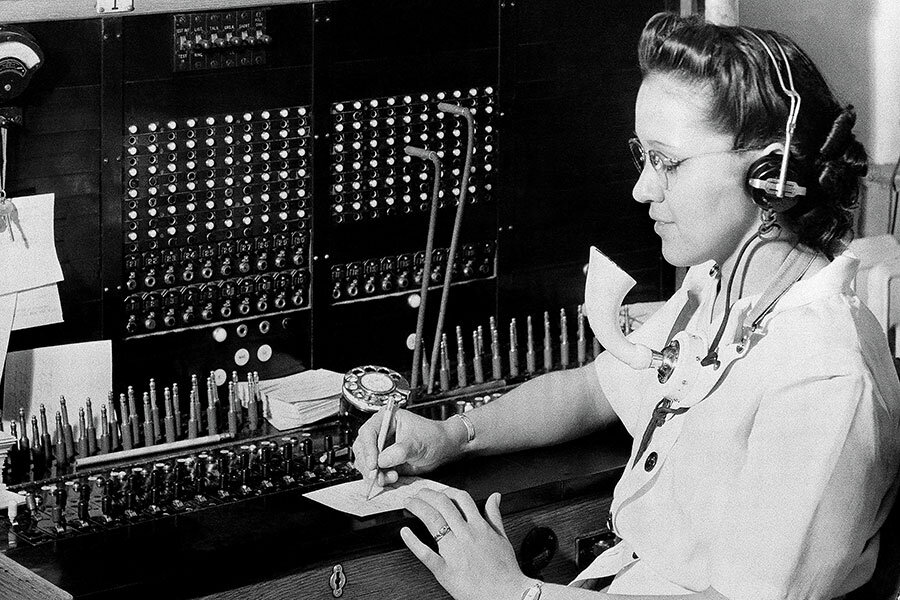‘Hello, Operator? I have a question ... ’
Loading...
One morning many years ago, when I was a college student, I wanted to talk to one of my professors before class. I picked up the phone and waited for the operator.
“Good morning. Number, please?”
“Could I speak to No. 11?”
“Steve has already gone to the office; that’s No. 12. But his wife, Upschur, is at home if you want her. Which shall I ring?”
It may be hard to believe that such a conversation occurred as recently as 1963, in Sewanee, Tenn. But dial telephones were slow to arrive in some small towns. Even in the 1980s, my town in New Hampshire had what we called a “mom and pop” telephone company. “Mom” was still one of the women who answered when you dialed zero, and “Pop” (in his younger days) had strung some of the telephone wires himself. I’m not sure exactly when it became improper for the operator to tell you if someone was away on vacation or just out for the day, but once the local company sold out to a larger one, we knew those days were gone.
My wife’s family has a long history with telephones.
Her father’s father, according to the family stories, was at one time owner of the Rhode Island Telephone and Electric Company. This was a small firm that strung some of the first wires in Providence, R.I. Her father worked stringing wires during the summers when he went to college at Brown University. He graduated in 1915 and became one of the first electrical engineers.
I spoke with him once when he was in his 90s, and he described doing the power calculations for the first long-distance direct-dialing plant. In those days, telephones had a rotary dial, and whenever the customer dialed a digit a mechanical rotary switch in the telephone office had to move the same number of positions, so a large telephone exchange building took a lot of power. The ground wire for the building, my father-in-law said, was a copper bar one inch thick and 12 inches wide that ran the length of the building.
When, as a young child in Maryland, I learned my grandmother’s telephone number, I was told to tell the operator, “Boston, please, Longwood 5301, collect.” (I think I was taught that “collect” meant that Grandmother would pay for the rather expensive call.) Then the number changed to “Longwood 6-5301.” The numeral 5 corresponds with the letter L on the telephone dial, of course, and 6 with the letters O and N. But 566-5301 and 617-566-5301 came years later.
Nowadays, exchange names are long gone and helpful human operators are a very pleasant surprise when you reach one. Several of my children and grandchildren have given up landlines altogether and use only cellphones. I still find it a bit confusing when I’m given five telephone numbers for the two parents and three children in a family.
The occasion can still happen, however, when you need to ask a question to get someone on the telephone. Shortly after my wife and I married – and long before we had a cellphone – she and I went shopping for a gift for a new grandson. My wife called her son from a store pay phone to ask a question. He said he’d consult his wife and call back. What we did not know, however, was that this particular pay phone was not able to receive incoming calls.
Shortly afterward, we were paged to come to the store manager’s desk. My wife’s son was on the phone, and he answered my wife’s question.
Meanwhile, an unusual number of clerks had gathered around us.
“What is your name?” one of them asked. “Is there a story about it?”
My wife’s enterprising son, after not being able to call us back on the pay phone, had looked up the store’s number. When someone answered, he’d asked, “Can you page my mom?”
“Yes, of course,” the person who’d answered the phone had said. “What’s her name?”
There’d been a long pause. Our marriage was pretty recent. “It’s er ... um ... it’s ... ” There was another long pause, and then a much louder tone of voice as he called to his wife, “Honey, what’s my mom’s name?”
If we can’t have all-knowing operators, it is sometimes nice to have all-knowing wives.





